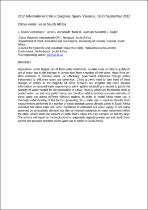JavaScript is disabled for your browser. Some features of this site may not work without it.
- ResearchSpace
- →
- Research Publications/Outputs
- →
- Conference Publications
- →
- View Item
| dc.contributor.author |
Vahrmeijer, JT

|
|
| dc.contributor.author |
Annandale, JG

|
|
| dc.contributor.author |
Gush, Mark B

|
|
| dc.contributor.author |
Taylor, NJ

|
|
| dc.date.accessioned | 2016-08-19T08:12:46Z | |
| dc.date.available | 2016-08-19T08:12:46Z | |
| dc.date.issued | 2012-09 | |
| dc.identifier.citation | Vahrmeijer, J.T., Annandale, J.G., Gush, M.B. and Taylor, N.J. 2012. Citrus water use in South Africa. In: 2012 International Citrus Congress, Spain, Valencia, 18-23 September 2012 | en_US |
| dc.identifier.isbn | 9789462610538 | |
| dc.identifier.uri | 10.17660/ActaHortic.2015.1065.220 | |
| dc.identifier.uri | http://hdl.handle.net/10204/8710 | |
| dc.description | 2012 International Citrus Congress, Spain, Valencia, 18-23 September 2012. Due to copyright restrictions, the attached PDF file only contains the abstract of the full text item. For access to the full text item, please consult the publisher's website. | en_US |
| dc.description.abstract | Agriculture, as the largest user of fresh water worldwide, is under close scrutiny to justify its use of water due to the increase in competition from a number of end-users. Apart from on-farm measures to increase water use efficiency, government intervenes through policy instruments to influence water use behaviour. Citrus growers need to take heed of these changes in policy as the majority of citrus orchards are irrigated and more detailed information on seasonal water requirements and irrigation scheduling is needed to justify the quantity of water needed for the production of citrus. Models, which are formidable tools to predict water use and crop performance, are therefore vital to provide accurate estimates of citrus water use across different climatic regions. In order to model citrus water use, a thorough understanding of the factors governing citrus water use is required. Results from measurements performed in a number of citrus orchards across climatic zones in South Africa indicated that citrus water use, under conditions of unlimited soil water supply, is not solely governed by atmospheric demand, but also by internal resistances to water movement within the plant, which limits the amount of water that a citrus tree can transpire on hot dry days. The authors will report on the institutional arrangements regarding water use and results from current and previous research on the water use in citrus in South Africa. | en_US |
| dc.language.iso | en | en_US |
| dc.publisher | Acta Horticulturae | en_US |
| dc.relation.ispartofseries | Workflow;15878 | |
| dc.subject | Citrus orchard | en_US |
| dc.subject | Crop coefficients | en_US |
| dc.subject | Evapotranspiration | en_US |
| dc.subject | Policy | en_US |
| dc.subject | Sap flow | en_US |
| dc.subject | Seasonal | en_US |
| dc.subject | Transpiration | en_US |
| dc.title | Citrus water use in South Africa | en_US |
| dc.type | Conference Presentation | en_US |
| dc.identifier.apacitation | Vahrmeijer, J., Annandale, J., Gush, M. B., & Taylor, N. (2012). Citrus water use in South Africa. Acta Horticulturae. http://hdl.handle.net/10204/8710 | en_ZA |
| dc.identifier.chicagocitation | Vahrmeijer, JT, JG Annandale, Mark B Gush, and NJ Taylor. "Citrus water use in South Africa." (2012): http://hdl.handle.net/10204/8710 | en_ZA |
| dc.identifier.vancouvercitation | Vahrmeijer J, Annandale J, Gush MB, Taylor N, Citrus water use in South Africa; Acta Horticulturae; 2012. http://hdl.handle.net/10204/8710 . | en_ZA |
| dc.identifier.ris | TY - Conference Presentation AU - Vahrmeijer, JT AU - Annandale, JG AU - Gush, Mark B AU - Taylor, NJ AB - Agriculture, as the largest user of fresh water worldwide, is under close scrutiny to justify its use of water due to the increase in competition from a number of end-users. Apart from on-farm measures to increase water use efficiency, government intervenes through policy instruments to influence water use behaviour. Citrus growers need to take heed of these changes in policy as the majority of citrus orchards are irrigated and more detailed information on seasonal water requirements and irrigation scheduling is needed to justify the quantity of water needed for the production of citrus. Models, which are formidable tools to predict water use and crop performance, are therefore vital to provide accurate estimates of citrus water use across different climatic regions. In order to model citrus water use, a thorough understanding of the factors governing citrus water use is required. Results from measurements performed in a number of citrus orchards across climatic zones in South Africa indicated that citrus water use, under conditions of unlimited soil water supply, is not solely governed by atmospheric demand, but also by internal resistances to water movement within the plant, which limits the amount of water that a citrus tree can transpire on hot dry days. The authors will report on the institutional arrangements regarding water use and results from current and previous research on the water use in citrus in South Africa. DA - 2012-09 DB - ResearchSpace DP - CSIR KW - Citrus orchard KW - Crop coefficients KW - Evapotranspiration KW - Policy KW - Sap flow KW - Seasonal KW - Transpiration LK - https://researchspace.csir.co.za PY - 2012 SM - 9789462610538 T1 - Citrus water use in South Africa TI - Citrus water use in South Africa UR - http://hdl.handle.net/10204/8710 ER - | en_ZA |






